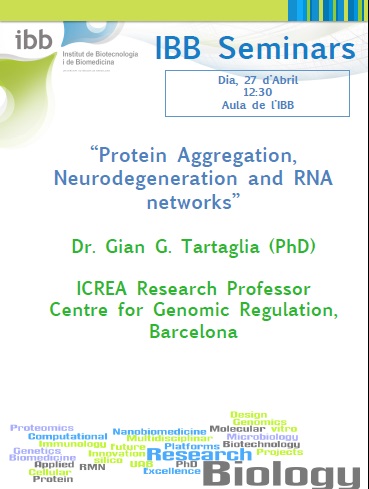
Dr. Gian Tartaglia; biografia i l’abstract de la xerrada.
Biography: Gian graduated at the University La Sapienza in the academic year 1999-2000 with a thesis on mathematical modeling of neurons (Physics department, B. Tirozzi). Between 2001 and 2005, he carried out his doctoral studies at the University of Zurich CH (Biochemistry department, A. Caflisch) focusing on the folding and misfolding of proteins associated with neurodegenerative disorders. As a fellow of Clare Hall college, Gian worked at the University of Cambridge UK (Chemistry and Genetics departments) under the supervision of C. Dobson and M. Vendruscolo. In the period 2005-2010, he participated in several computational and experimental studies on amyloidosis supported by Swiss National Science Foundation (CH) and Medical Research Council (UK). In 2010 Gian started his own laboratory at the Centre for Genomic Regulation (Bioinformatics and Genomics department; Barcelona, Spain) and was later tenured in 2014 by the Institució Catalana de Recerca i Estudis Avançats ICREA (Life and Medical Sciences). His group, supported by the European Research Council and other grants such as Wellcome trust and Horizon H2020, collaborates with a number of international partners (Annalisa Pastore – King’s college London UK, Ina Vorberg – DZNE Bonn, Ulrich Hartl – Max Plank Munich DE and Peter Hyslop, Cambridge UK to cite some). His present research focuses on both computational and experimental approaches to navigate the uncharted territory of molecules involved in gene regulation (e.g., X-chromosome inactivation) as well as human disorders (e.g., Parkinson’s disease).
Abstract: Nucleic acids and proteins are the most important biomolecules in any organism, with the former carrying genetic information and the latter executing and regulating life processes. Characterizing protein interactions [1] is key to unravel the functionality of genomes [2] and can open up therapeutic avenues for the treatment of a broad range of diseases. In this talk, I will focus on the work done in my laboratory to study the role played by proteins and RNAs in transcriptional and translational regulation as well as neurodegenerative disorders (examples include Parkinson’s a-synuclein, Alzheimer’s disease amyloid protein APP, TDP-43 and FUS)[3,4]. Using both computational and experimental approaches, we aim to discover the involvement of RNA molecules in regulatory networks controlling protein production. More specifically, I am interested in understanding mechanisms whose alteration lead to aberrant accumulation of proteins [5]. We have previously observed that interactions between proteins and their messenger RNAs induce feedback loops that are crucial in protein homeostasis [3,4]. Recently, we started to work on the interactions of mystery trascripts, the long non coding RNAs [6].
1. Bellucci, M., Agostini, F., Masin, M. & Tartaglia, G. G. Predicting protein associations with RNAs. Nat. Methods 8, 444–445 (2011).
2. Cirillo, D. et al. Constitutive patterns of gene expression regulated by RNA-binding proteins. Genome Biol. 15, R13 (2014).
3. Zanzoni, A. et al. Principles of self-organization in biological pathways: a hypothesis on the autogenous association of alpha-synuclein. Nucleic Acids Res. 41, 9987–9998 (2013).
4. Cirillo, D. et al. Neurodegenerative diseases: Quantitative predictions of protein-RNA interactions. RNA N. Y. N 19, 129–140 (2013).
5. Bolognesi, B. et al. A Concentration-Dependent Liquid Phase Separation Can Cause Toxicity upon Increased Protein Expression. Cell Rep. 16, 222–231 (2016).
6. Cirillo D, et al. Quantitiative predicitons of protein interactions with long non coding RNAs. Nat Methods. 2017 Jan 1;14(1):5-6. doi: 10.1038/nmeth.4100
